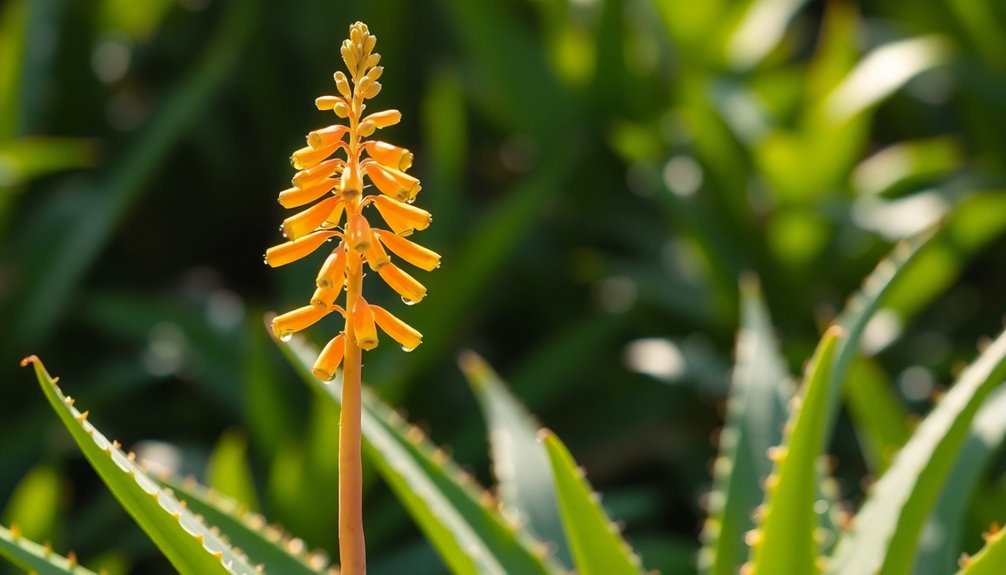Did you know that aloe vera is a flowering plant? It can surprise many, as it's often recognized for its lush, succulent leaves. When your aloe is at least four years old, it can produce stunning clusters of tubular flowers in vibrant colors like yellow, orange, and red during late spring or summer. With the right conditions—plenty of sunlight and careful care—your aloe can bloom beautifully, revealing more fascinating details about this remarkable plant.
Key Takeaways
- Yes, aloe vera is a flowering plant that blooms typically in late spring to early summer when it reaches about four years of age.
- Aloe vera flowers are vibrant, tubular clusters that can be yellow, orange, red, white, or pink, rising above the plant's thick green leaves.
- To encourage blooming, aloe vera needs six to eight hours of direct sunlight daily and stable temperatures between 70°F and 85°F.
- Indoor aloe vera requires careful care, including sufficient light, infrequent watering, and monthly fertilization to promote flowering.
- Healthy aloe vera plants produce beautiful flowers that attract pollinators and can generate viable seeds for propagation.
Understanding Aloe Vera as a Flowering Plant

Have you ever wondered what makes aloe vera not just a popular succulent but also a stunning flowering plant? Aloe vera flowers are a beautiful sight, typically blooming when the plant is at least four years old during late spring or early summer.
These flowering aloe vera plants produce eye-catching tubular flowers in vibrant colors like yellow, orange, red, white, or pink, which grow in dense clusters atop long stalks.
To grow Aloe that blooms, guarantee it gets six to eight hours of direct sunlight daily, along with proper watering and temperature conditions. Generally, mature aloe vera plants bloom once a year for two to three weeks, but in tropical climates, they may flower multiple times.
Cutting back spent flower stalks helps promote future growth.
Conditions Required for Aloe Vera to Bloom
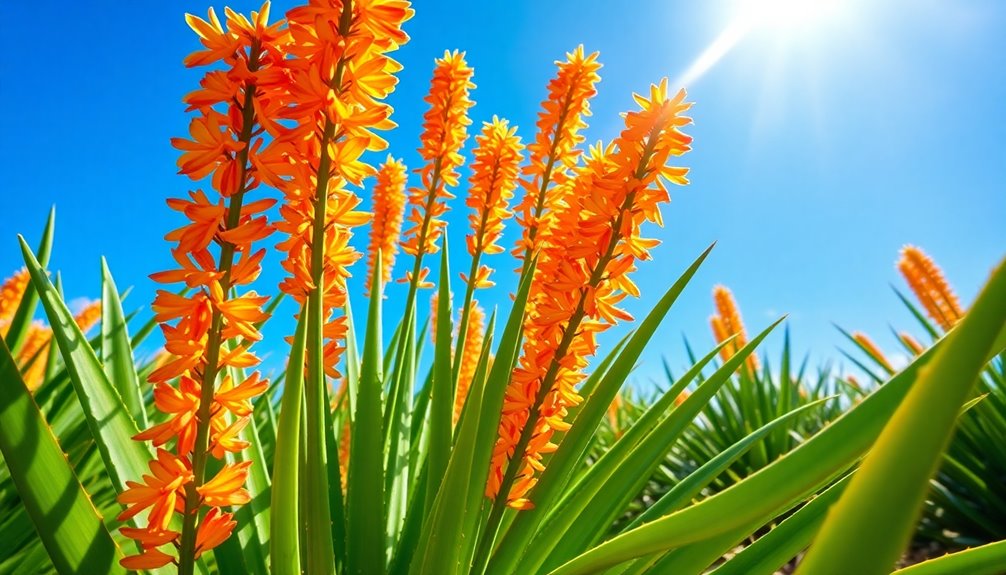
To guarantee your aloe vera blooms, you need to create the right conditions for growth.
First, verify your aloe plants are at least four years old, as maturity is vital for flowering. They thrive in bright sunlight, requiring a minimum of six hours daily—full sun exposure is best.
Keep temperatures stable between 70°F and 85°F; anything below 55°F can stunt growth and prevent blooms.
During the growing season, water regularly but cautiously, and cut back in winter.
Fertilizing once a month with a diluted liquid 10-40-10 fertilizer will also stimulate blooming.
The Appearance of Aloe Vera Flowers
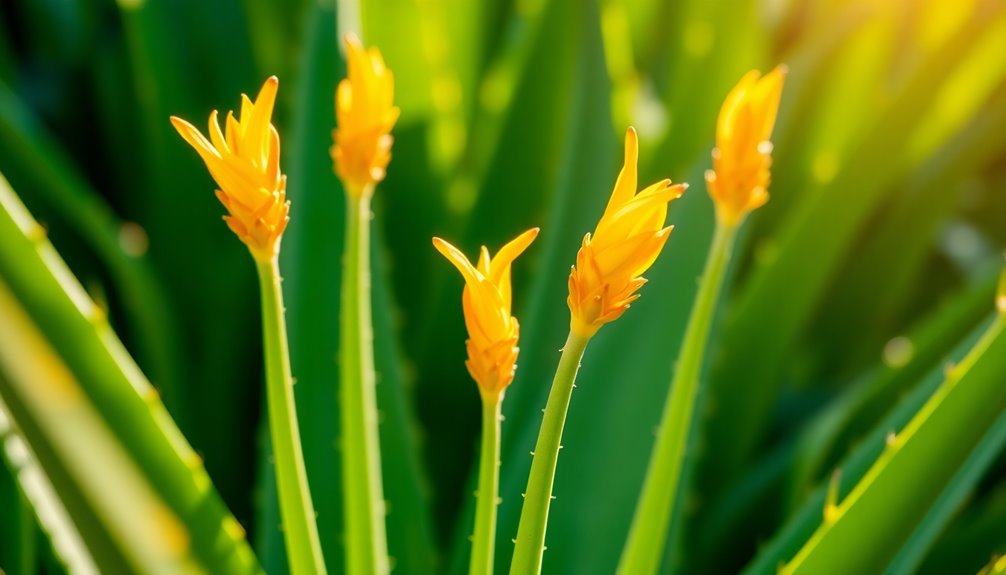
When mature, aloe vera plants reveal stunning clusters of spiky, tubular flowers, enchanting anyone who sees them. These vibrant blooms come in colors like yellow, orange, red, white, and pink, brightening up gardens and homes alike. Rising above the thick, green leaves, the long stalks showcase dense clusters of flowers that bloom from the top down. Typically, you'll spot these beauties blooming in late spring or early summer, lasting two to three weeks each year. In tropical regions, blooming can happen multiple times per season, with the specific appearance varying by aloe variety.
| Color | Description | Emotion |
|---|---|---|
| Yellow | Bright and cheerful | Joy |
| Red | Bold and striking | Passion |
| Pink | Soft and gentle | Love |
How to Encourage Your Aloe Vera to Flower
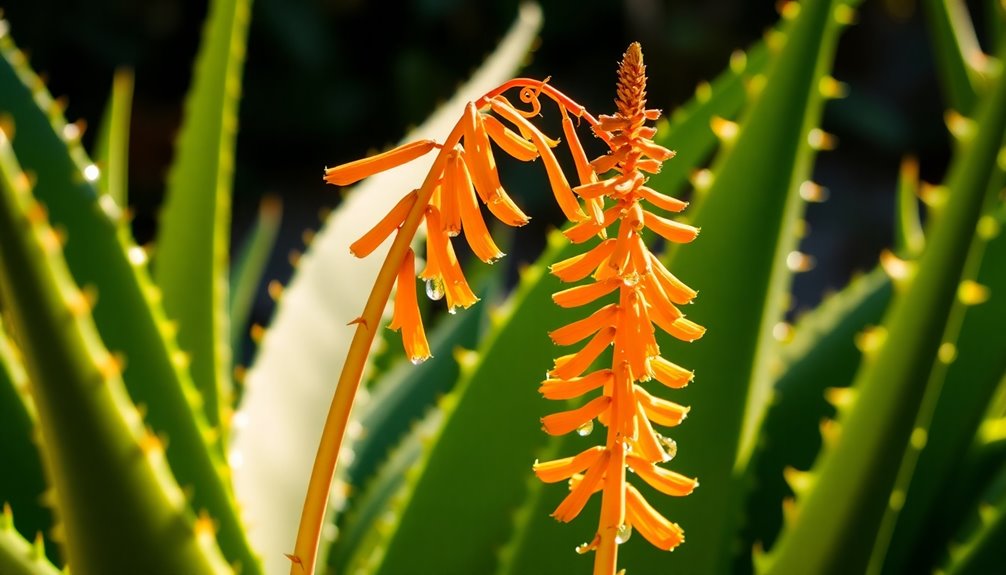
Encouraging your aloe vera to flower requires attention to its age and environmental conditions.
To promote blooming, verify your aloe vera plants need the following ideal conditions:
- Age: Confirm your plant is at least four years old.
- Sunlight: Provide 6-8 hours of direct sunlight daily.
- Temperature: Maintain stable temperatures between 70°F and 85°F; avoid temperatures below 55°F.
- Fertilization: Use a diluted 10-40-10 houseplant fertilizer once a month during the growing season.
- Watering: Water regularly in the growing season but allow the soil to dry completely in winter.
The Importance of Sunlight for Aloe Blooming
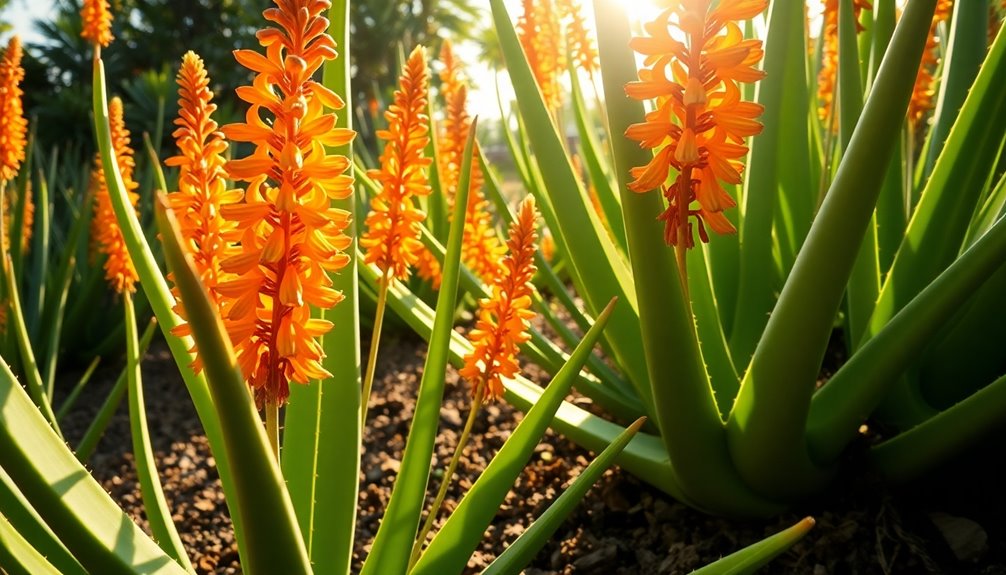
Providing your aloe vera with ample sunlight plays a crucial role in its ability to bloom. For ideal flowering, your plant needs at least six hours of bright sunlight daily. Here's a quick overview of sunlight requirements for aloe vera:
| Sunlight Type | Hours Needed | Effect on Flowering |
|---|---|---|
| Full Sun | 6-8 hours | Increases blooming chance |
| Partial Shade | 4-5 hours | May hinder blooming |
| Indoor Light | 2-3 hours | Insufficient for blooming |
| Outdoor Growing | Seasonal | Enhances flowering potential |
Moving your potted aloe vera outdoors during the growing season can greatly boost its chances of flowering. Remember, the best blooming typically happens in late spring or early summer when your plant receives the right amount of sunlight.
Fertilizing Guidelines for Flowering Aloe Vera
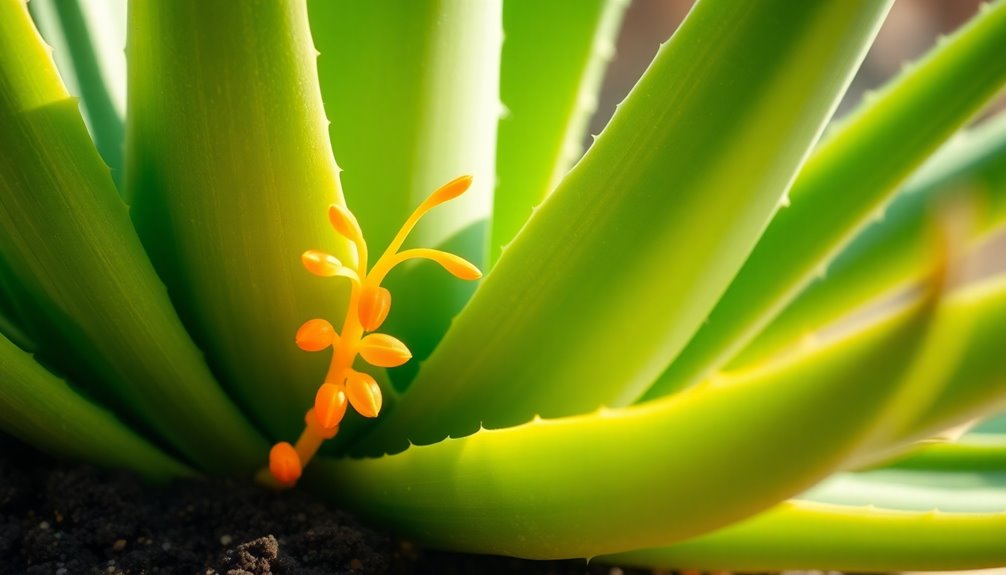
To help your aloe vera thrive and produce beautiful flowers, you'll want to focus on the right fertilizer types and ratios.
Fertilizing at the right times and frequencies can make a big difference in its growth.
Let's explore how to optimize your fertilization routine for the best results.
Fertilizer Types and Ratios
Fertilizing your aloe vera correctly can greatly impact its growth and flowering potential.
To guarantee your plant thrives and can produce flowers, consider these fertilizer types and ratios:
- Use a diluted liquid 10-40-10 houseplant fertilizer once a month during the growing season.
- Avoid high phosphorus or super phosphate fertilizers, as they can harm your plant.
- Apply a balanced fertilizer in early spring and midsummer to boost flowering chances.
- Always water after fertilizing to prevent salt buildup and improve nutrient absorption.
- Transplant your aloe every two years to refresh the soil and aerate the roots.
Timing and Frequency
While it's important to provide the right nutrients for your aloe vera, timing and frequency play a crucial role in its ability to bloom.
Fertilize your plant no more than once a month during the growing season, using a diluted liquid 10-40-10 houseplant fertilizer. Early spring and midsummer are the best times to fertilize, ensuring your aloe gets the nutrients it needs when it's actively growing.
After fertilizing, water the plant to prevent salt buildup in the soil, which can harm roots and hinder blooming. Avoid high phosphorus or super phosphate formulas, as they can negatively impact growth.
During winter, reduce or eliminate fertilization to let your aloe rest and prepare for the next growing season.
Indoor Aloe Vera Care for Successful Blooming
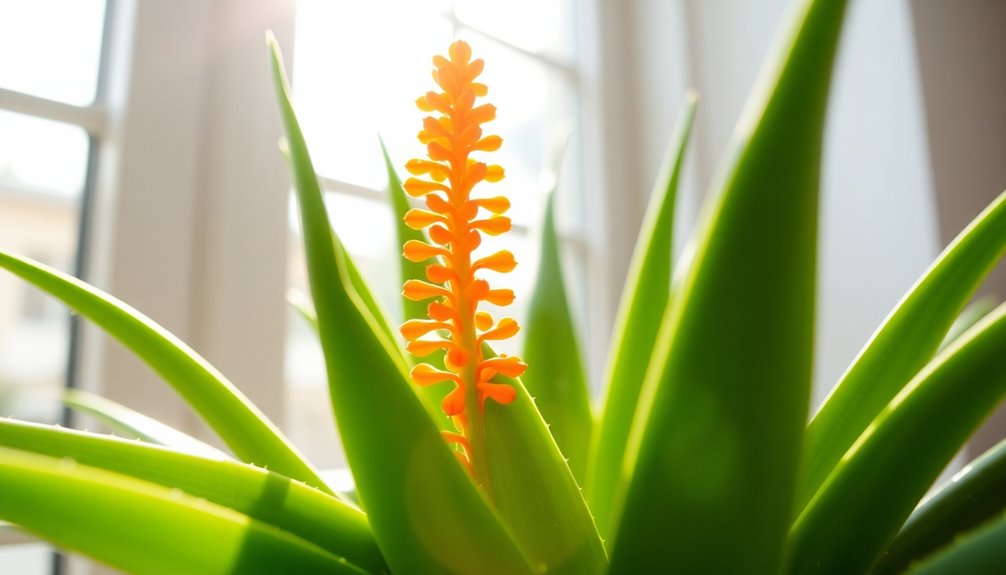
To get your indoor aloe vera to bloom, focus on providing ideal lighting, consistent watering, and proper fertilization.
Make sure it gets six to eight hours of direct sunlight each day, and water it every 2-3 weeks, letting the soil dry out completely in between.
Additionally, fertilize every couple of months to give your plant the nutrients it needs for successful growth and flowering.
Optimal Lighting Conditions
For your indoor aloe vera to thrive and potentially bloom, guaranteeing it gets enough light is essential. Here are some tips to achieve ideal lighting conditions:
- Place your aloe vera near south-facing windows for maximum bright sunlight exposure.
- Aim for at least six to eight hours of direct sunlight daily.
- If natural light is insufficient, consider using grow lights to supplement.
- Regularly rotate the plant to guarantee all sides receive equal sunlight.
- Keep temperatures stable between 55°F and 85°F to support blooming.
Watering Frequency Guidelines
Watering your indoor aloe vera correctly is essential to its health and blooming potential. Aim to water every 2-3 weeks, allowing the soil to dry completely between waterings. This prevents overwatering, which can lead to root rot and hinder blooming.
Different aloe varieties may have slightly different needs, but the general rule applies across the board. During winter, reduce your watering frequency, as your aloe may enter a dormant period and require less moisture.
Make sure your container has drainage holes to let excess water escape. Keep an eye on your plant; if the leaves start to dry out and turn bronze, it's a sign to increase care and prepare for a potential flower spike.
Fertilization for Growth
While many factors contribute to the growth and blooming of your indoor aloe vera, proper fertilization plays an essential role.
To guarantee your plant thrives and has the best chance to bloom, keep these tips in mind:
- Use a diluted liquid 10-40-10 balanced fertilizer once a month during the growing season.
- Fertilize in early spring and midsummer to stimulate growth.
- Water your plant after fertilizing to prevent salt buildup.
- Avoid high phosphorus or super phosphate formulas for healthier plants.
- Transplant every two years to refresh soil and aerate roots.
With the right fertilization for growth and ample sunlight, you’ll set the stage for your aloe vera to flourish and bloom beautifully! In addition to providing a nurturing environment, it’s crucial to monitor the watering schedule to prevent overhydration, which can lead to root rot. Moreover, regularly cleaning the leaves can help the plant absorb sunlight more efficiently. As you cultivate your aloe vera, you’ll discover why its appeal extends beyond aesthetics; many enthusiasts are eager to learn about the aloe vera health benefits explained, showcasing its remarkable properties for soothing skin and aiding digestion. By incorporating aloe vera into your daily routine, you can unlock an array of health perks that go beyond its visual charm. Many enthusiasts appreciate its versatility, not only using it in topical applications but also exploring its inclusion in delicious recipes and beverages, particularly those highlighting green juice nutritional benefits. This way, you can nourish your body from the inside out while enjoying all the stunning benefits of this remarkable plant!
Common Challenges in Getting Aloe Vera to Flower
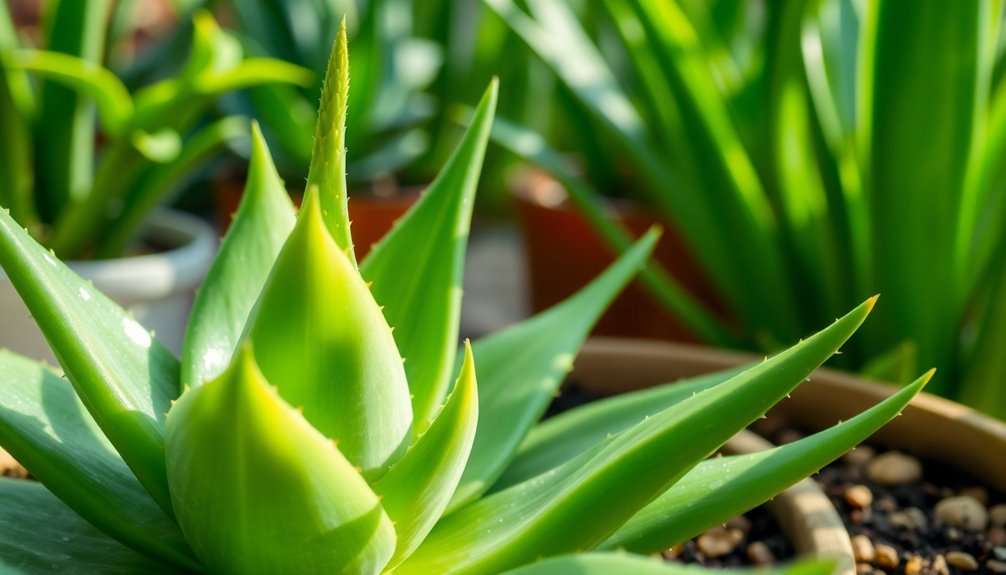
Getting your Aloe vera to flower can be challenging, especially since these plants need to reach at least four years of age before they bloom.
To encourage those stunning Aloe plant blooms, you'll need to provide the right growing conditions. Bright sunlight is essential, so aim for at least six hours daily; without it, your plant may struggle to flower, particularly indoors.
Maintain stable temperatures between 70°F and 85°F, as anything below 55°F can shock your Aloe and prevent blooming.
Additionally, be cautious with watering during the growing season—overwatering can lead to root rot and diminish flowering potential.
Finally, fertilize only once a month with a diluted 10-40-10 fertilizer to avoid nutrient burn, which can hinder flower development.
The Benefits of Aloe Vera Blooms and Plant Health
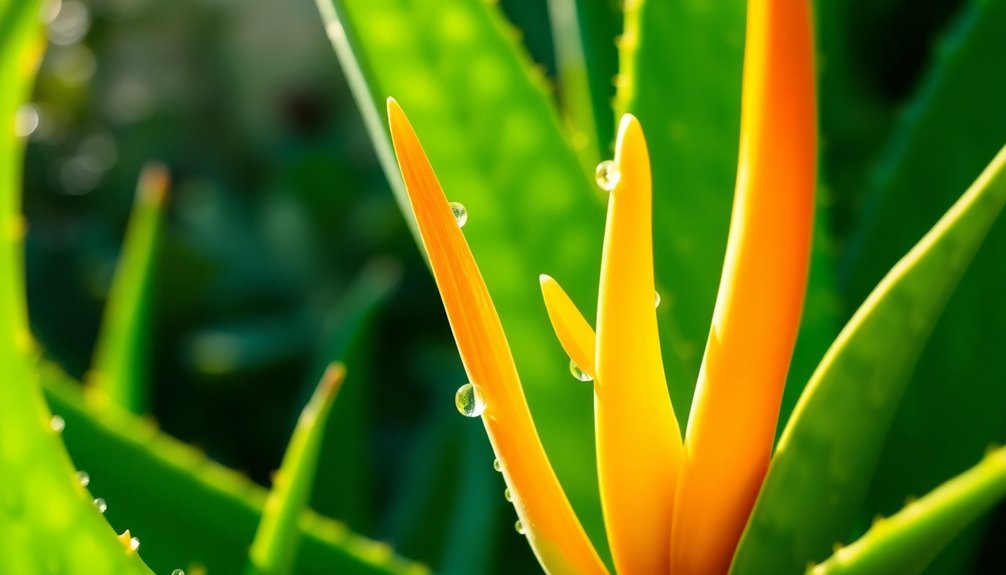
Aloe vera blooms not only enhance the beauty of your garden or indoor space but also signal a thriving, healthy plant. When you see those vibrant flowers, it's a sign that your aloe is flourishing.
The benefits of Aloe go beyond aesthetics; these flowers contribute to plant health and can even aid your skin. Here are some key advantages of aloe blooms:
- Brightly-colored flowers improve visual interest.
- They indicate ideal growing conditions and plant health.
- Aloe flowers contain antioxidants that may reduce inflammation.
- Producing flowers can lead to viable seeds for new plants.
- Enjoying these blooms showcases your gardening efforts.
Frequently Asked Questions
Is a Aloe Vera a Flowering Plant?
Yes, aloe vera is a flowering plant. When your aloe reaches maturity, which usually takes around four years, it can produce vibrant flowers in clusters.
These blooms typically appear in late spring or early summer, showcasing colors like yellow, orange, and red.
To encourage flowering, make sure your plant receives at least six hours of bright sunlight daily and maintains stable temperatures between 70°F and 85°F.
Proper care can lead to beautiful blossoms each year.
What Does It Mean When Someone Gives You an Aloe Vera Plant?
When someone gives you an aloe vera plant, it's like receiving a little green hug. This gesture symbolizes good luck and prosperity, reflecting their wish for your well-being.
Aloe vera's soothing properties make it a thoughtful gift, especially if you might need some healing. Plus, it shows they care about your friendship and want your relationship to thrive, much like this resilient plant that flourishes with minimal effort.
Is It Rare for an Aloe Plant to Flower?
It's not rare for an aloe plant to flower, but it does depend on certain conditions.
If you're caring for a mature aloe, ideally over four years old, you might see blooms once a year during late spring or summer.
However, if you've got it indoors, the lack of light and warmth could hinder blooming.
In tropical climates, some varieties can flower multiple times, showcasing their adaptability.
What Does It Mean When an Aloe Plant Blooms?
When an aloe plant blooms, it means it's reached maturity and is in prime health.
You'll notice a tall stalk topped with clusters of vibrant flowers, which can be various colors depending on the type. This blooming typically happens in late spring or early summer, signaling that your plant is thriving.
After flowering, it's a good idea to cut off the spent stalk to help your aloe focus on new growth and maintain its health.
Conclusion
To sum up, now you know that aloe vera isn't just a succulent; it's a flowering plant! With the right care, like plenty of sunlight and proper fertilization, you can encourage your aloe to bloom beautifully. Did you know that mature aloe plants can produce flower spikes up to three feet tall? So, don't be discouraged if you haven't seen blooms yet—just give your aloe a little TLC, and you might be surprised by the results!
Cindy thoroughly researches juicing trends, techniques, and recipes to provide readers with practical advice and inspiration. Her writing style is accessible, engaging, and designed to make complex concepts easy to understand. Cindy’s dedication to promoting the advantages of juicing shines through her work, empowering readers to make positive changes in their lives through the simple act of juicing.

